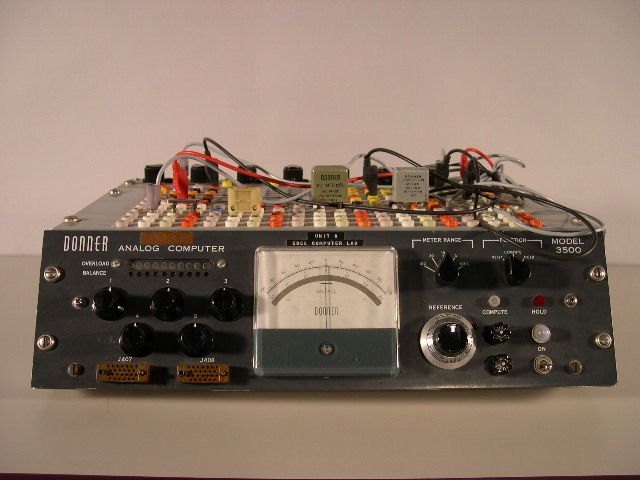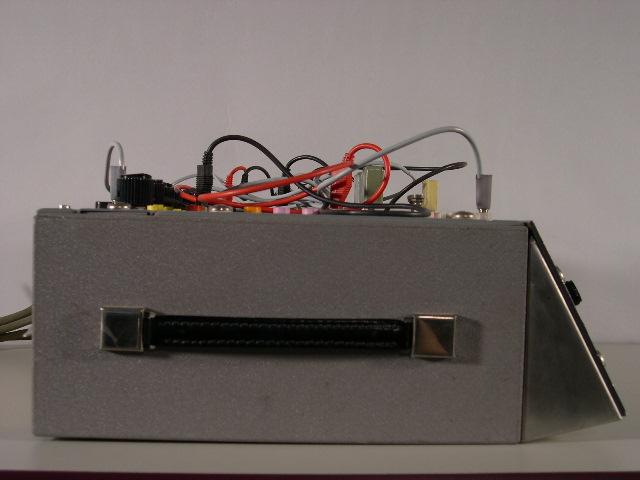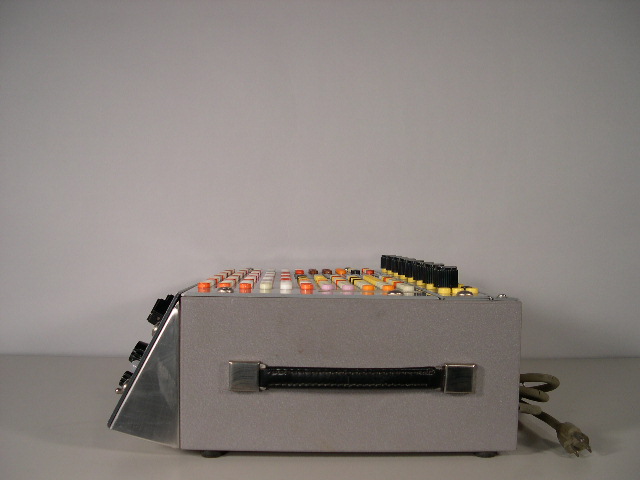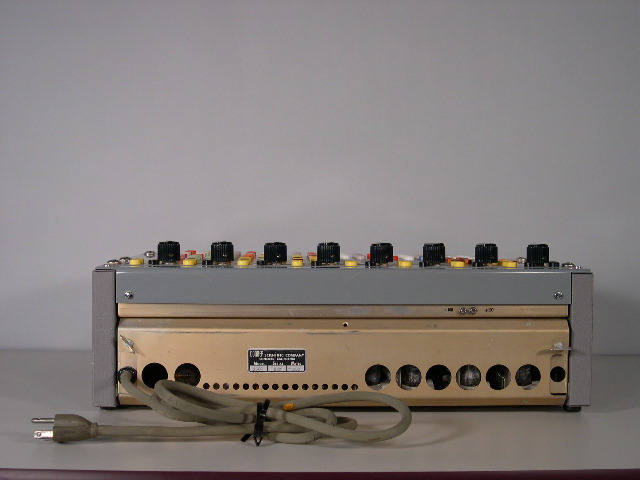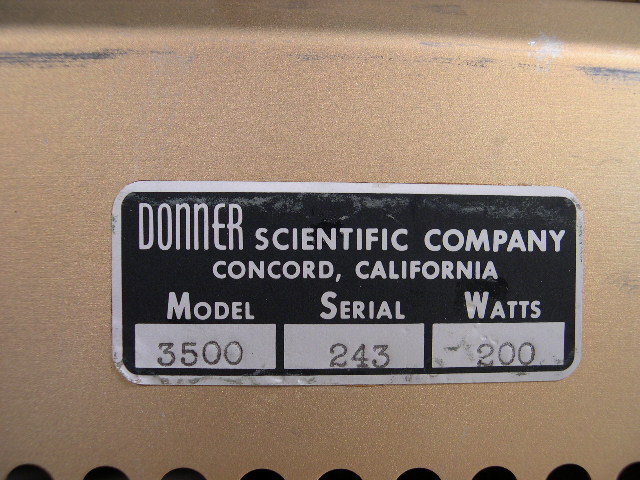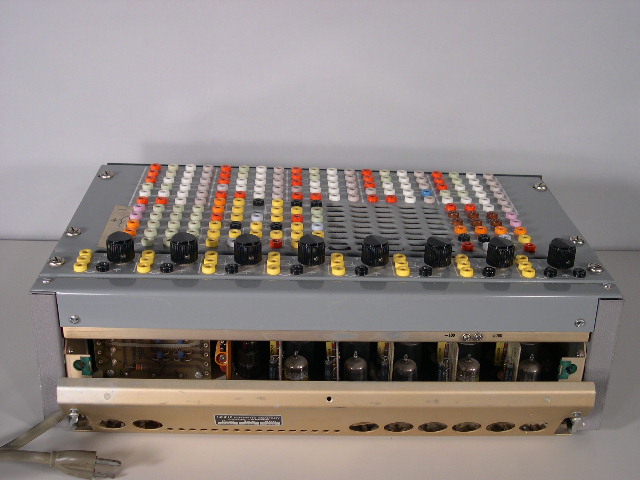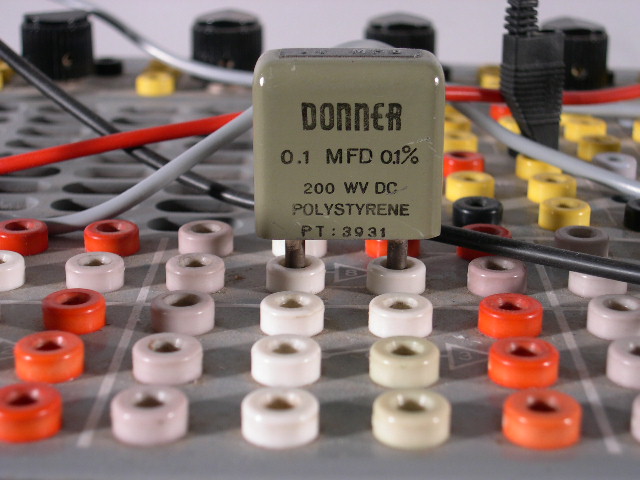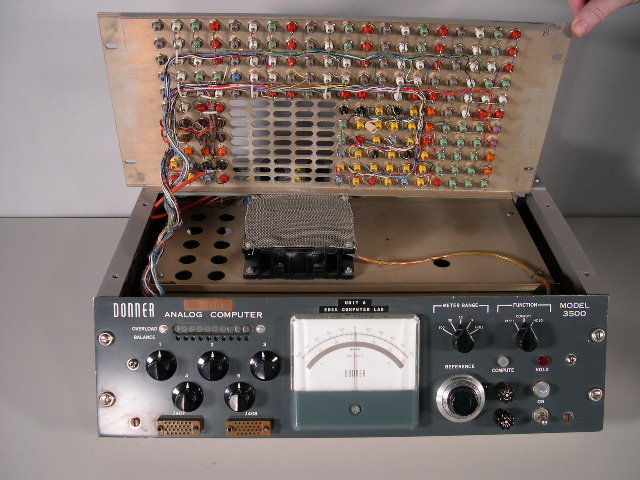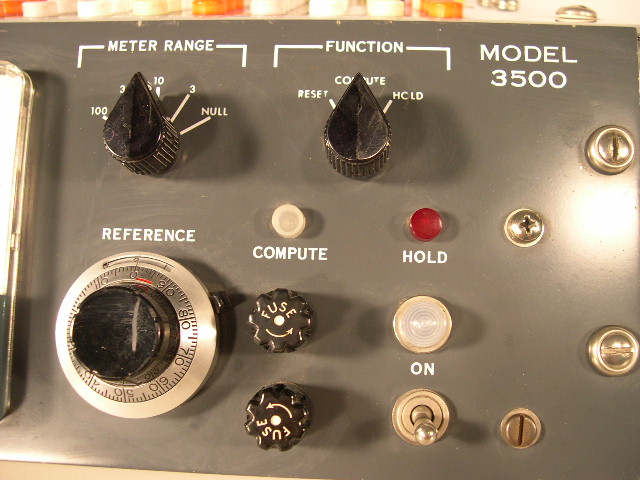 |
We are brick & mortar now!!
Visit us in Parkesburg, PA For more info: www.TheComputerChurch.org (This site no longer maintained.) |
YEAR: late 1950's
COMPANY: Donner Scientific Company
COUNTRY: U.S.A.
IN OUR COLLECTION: Yes
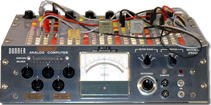
The Model 3500 is a unique portable, analog computer. Weighing just 28 pounds and sporting two leather handle straps (one at each side) the 3500 was designed for use by scientists and engineering designers who could easily move the computer from one place to another. It could be used as a versatile signal generator, data reduction or signal conditioning at test sites, and as a general purpose computer in the classroom, field, or desk. Use for the classroom was convenient with 2 detachable problem boards controlling half the computer. There is a remote control for field testing. It was probably first offered for sale in the late 1950's. It was designed so that it could be a free-standing computer or it could be reconfigured to be rack mounted. The one in our collection is slightly different from those pictured in the "Instruction Manual Model 3500" in that it has a protruding, angled front control panel. We don't know if this is a standard factory version of the 3500 or a later customization.
How did you operate it?
Operating this computer wasn't easy. The Instruction Manual states that the 3500 should "warm up for at least ten minutes" before use. In addition, the manual recommends "a daily or weekly check should be made of the +300V and -150V power supply output voltages." [So don't complain next time your computer takes 30 seconds to power up!]
Porgramming was done by patchcords. This means that is you wanted to program the analog computer to solve an equation you had to configure the patchcords in just the right way. And if you then wanted to solve another equation...you had to unplug all the patchcords and reconfigure them. Imagine having to use patchcords instead of your keyboard or mouse or touchpad to enter information into your computer.
History of the Donner Scientific Company
Donner Scientific Company was founded in 1953 in Berkeley, CA by William Rosenberry and was named after Donner Pass. The company moved to Concord, CA in 1954. They began making the Model 30 Analog Computer (a vacuum tube computer) and sold 600 units between 1954 and 1960. Donner Scientific merged with Systron Corp. to become Systron Donner Corp. on March 31, 1960.
Systron Donner is still in existence in the same city. They are called "Systron Donner Interial" and make sensing devices (such as gyroscopes) for all sorts of modern tecnologies such as the Mars Rover (really, they are on Mars!), military helicoptions, UAVs, torpedoes and robots.
The Donner 3500 was an early item in their extensive analog computer line. Later, Donner invented solid state chopper stabilized operational amplifiers with an output of plus/minus 100 volts. These went into large rack size analog computers with one hundred or more amplifiers. The programming boards were removable modular units so a program could be set up at your desk and the unit plugged into the computer mainframe. Donner was not named after Donner Pass but after the Donner Labratory at U. C. Berkeley. N.B. I was employed by Donner (later Systron-Donner) for 45 years. .
I have a Datanumerics DL-8A front panel blinking-lights computer from about 1976. It's the only one I know of still in existence. Just thought I'd make it known that there is one, and it still works :)
|
Copyright © 2025 by Early Computers Project, All Rights Reserved. |
(Analogs in blue)
- AIM-65 (single board)
- AIM-65 (factory case)
- AIM-65 (Jon Titus)
- ALICE micro-ordinateur
- Altair 680
- Altair 8800
- Altair 8800A
- Altair 8800b
- Altair 8800b Turnkey (see Pertec below)
- Altair 8800b (see Pertec below)
- Altair 8800b w/ Hardisk Controller & Datakeeper
- Altos ACS-8000
- American Basic Science Club Analog Computer
- AMF Educational Computer
- Apple II Plus
- ASCI SystemX
- ASR 33 Teletype
- Automatic Teaching Computer Kit
- Beckman ElectroComp Electric Heating Computer
- Beckman ElectroComp Energy Savings Computer
- Beckman Solid State Fuel Cost Computer
- Brainiac K-30
- Calif. Computer Systems 2200
- CES Ed-Lab 650
- Commodore 8032
- Commodore 64
- Commodore PET 2001
- Commodore Super Pet
- Compucolor II
- Compukit 1
- Compukit 1 Deluxe Model
- Compukit 2
- Compukit UK101
- Comspace CT-650
- Cosmac Elf (RCA1802)
- Cosmac Microtutor
- Cosmac Netronics ELF II
- Cosmac VIP
- Cromemco System I
- Cromemco System III
- Cromemco Z-2D
- Datapoint 2200
- Digi-Comp I (flat box)
- Digi-Comp I (square box)
- Digital Computer Lab
- Donner 3500
- Durango F-85
- Dynabyte
- E & L Inst MMD-1
- E & L Inst MMD-2
- Eagle II
- Electric Tabulating Machine (one original counter, 1889)
- Electronic Associates TR-10
- Electronic Associates TR-10 Model II
- Electronic Associates TR-20
- Electronic Associates TR-48
- Electronic Associates Model 180
- Electronic Associates Model 380 Hybrid
- Geniac
- Google Glass (definitely not vintage)
- Heath EC-1 (factory assembled by Heath)
- Heathkit EC-1 (kit)
- Heathkit ET 3100 trainer
- Heathkit H8
- Heathkit H9 Video Terminal
- Hickok Logic Teaching Sys.
- Hickok Servo Teaching Sys.
- HP 2115A
- HP 85
- HP 5036A
- HP 9825A
- HP 9825B
- HP 9830A
- Iasis 7301
- I-COR MAC-1
- ICS Microcomputer Training System
- IMSAI 108 (prototype)
- IMSAI 8048 Control Computer
- IMSAI 8048 (The Dollhouse Computer)
- IMSAI 8080
- IMSAI PCS-40
- IMSAI PCS-80
- IMSAI VDP-80
- Informer
- Intel Intellec MDS
- Intel MDS-800
- Intel Prompt 48
- Intel SBC 80/10
- Intel SDK-85
- Intel SDK-85 (unassembled)
- Intel SDK-86
- Intertec Superbrain
- ITT MP-EX
- JR-01 Computer
- KIM-1
- LAN-DEC
- LAN-DEC 20
- LAN-ALOG
- Lehrcomputer (Germany)
- Lawrence Livermore Lab
- Lear Siegler ADM3A
- Logikit LK255 (Feedback)
- Logix SF-5000 Electronic Computer
- MAC-1 Mini Analog Computer
- MAC Tutor (Bell Laboratories)
- MEK6800D2
- Micro 68
- Microtan 65
- Midwest Scientific Instruments 6800
- Minivac 601
- Minivac 6010
- Mini-Scamp Microcomputer
- Nascom I
- Nascom II
- National Radio Institute 832
- NEC TK-80
- NorthStar Horizon
- Olivetti Programma 101
- Olivetti Programma 203
- Olivetti Programma 602
- Open University PT501
- Ordinateur d'Apprentissage JR-01
- Osborne 1
- OSI 300
- OSI 600 (SuperBoard II)
- OSI C2-OEM-4
- OSI Challenger-1P
- Pastoriza Personal Analogue Computer
- Pertec MITS 300/25 (Altair desk business system)
- Pertec MITS 300/55 (Altair Turnkey business system)
- PolyMorphic Systems 8810
- PolyMorphic Poly-88
- Protech-83
- Range Keeper Mk.6 Mechanical Analog Computer, 1926
- Range Keeper Mk.7 Mechanical Analog Computer, 1935?
- Sargent-Welch Scientific Company Cat. No.7528 Analog Computer
- Science of Cambridge MK-14 (Sinclair)
- SD Systems Z80 starter kit
- Sharp MZ-40K
- Sharp MZ-80k
- Siemens ECB-85
- Signetics Instructor 50
- Sinclair ZX-81
- Smoke Signal Broadcasting
- Sol-20
- Spark16
- Sphere 1
- Sphere/SWTPC Computer System
- SWTP CMOS Microlab
- SWTP CT-82 Terminal
- SWTPC 6800
- SWTPC 6800 (w/ Smoke Signal Broadcasting drive)
- SWTPC CT-64 Video Terminal, SS-50
- SWTPC TV Typewriter II CT-1024
- Synertek VIM-1
- Synertek SYM-1
- Systron-Donner 3500
- Tei MCS-112
- Tektronix 4006-1
- Telefunken RAT 700
- TI LCM-1001 (Microprogrammer)
- TI LCM-1001 (Microprogrammer)
- TI Silent 700 Terminal
- TI TM 990/189
- Vector 1
- Vector 3
- Vidac 336
- Wang 2200
- Welch Scientific Company Cat. No.7528 Analog Computer
- Xerox 820 Mark I
- Chameleon Plus
- Commodore SX64
- Epson HX-20
- Kaypro I
- Kaypro II
- Kaypro 2x
- Kaypro 16
- Osborne 1
- Panasonic Senior Partner
- Visual Commuter
- Babbage's Calculating Engine (1834)
- Electric Tabulating Machine (1889, Herman Hollerith's personal copy)
- The Hollerith Electric Tabulating System (1890)
- Counting a Nation by Electricity (1891)
- Calculating Machines (1947)
- Moore School Lectures Vol. II (1947)
- Mathematical Theory of Communication (1948)
- Communication Theory of Secrecy Systems (1949)
- The "Moore's Law" article (Electronics, 1965)
- Printout from Babbage's Difference Engine #2 (London Science Museum, 2004)
